formerly eScholarship Editions


|
|
|
|
Your search for
'Jewish Studies' in subject
found 69 book(s). | Modify Search | Displaying 41 - 60 of 69 book(s) | |
| 41. | 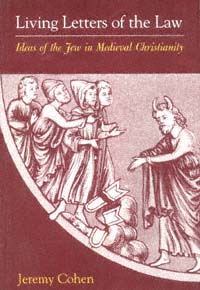 | Title: Living letters of the law: ideas of the Jew in medieval Christianity Author: Cohen, Jeremy 1953- Published: University of California Press, 1999 Subjects: Jewish Studies | Religion | Medieval History Publisher's Description: In Living Letters of the Law , Jeremy Cohen investigates the images of Jews and Judaism in the works of medieval Christian theologians from Augustine to Thomas Aquinas. He reveals how - and why - medieval Christianity fashioned a Jew on the basis of its reading of the Bible, and how this hermeneutically crafted Jew assumed distinctive character and power in Christian thought and culture.Augustine's doctrine of Jewish witness, which constructed the Jews so as to mandate their survival in a properly ordered Christian world, is the starting point for this illuminating study. Cohen demonstrates how adaptations of this doctrine reflected change in the self-consciousness of early medieval civilization. After exploring the effect of twelfth-century Europe's encounter with Islam on the value of Augustine's Jewish witnesses, he concludes with a new assessment of the reception of Augustine's ideas among thirteenth-century popes and friars.Consistently linking the medieval idea of the Jew with broader issues of textual criticism, anthropology, and the philosophy of history, this book demonstrates the complex significance of Christianity's "hermeneutical Jew" not only in the history of antisemitism but also in the broad scope of Western intellectual history. [brief] Similar Items |
| 42. | 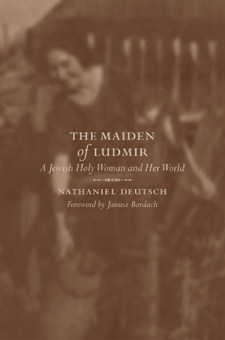 | Title: The maiden of Ludmir: a Jewish holy woman and her world Author: Deutsch, Nathaniel Published: University of California Press, 2003 Subjects: Jewish Studies | Women's Studies | European History | Judaism | Autobiographies and Biographies Publisher's Description: Hannah Rochel Verbermacher, a Hasidic holy woman known as the Maiden of Ludmir, was born in early-nineteenth-century Russia and became famous as the only woman in the three-hundred-year history of Hasidism to function as a rebbe - or charismatic leader - in her own right. Nathaniel Deutsch follows the traces left by the Maiden in both history and legend to fully explore her fascinating story for the first time. The Maiden of Ludmir offers powerful insights into the Jewish mystical tradition, into the Maiden's place within it, and into the remarkable Jewish community of Ludmir. Her biography ultimately becomes a provocative meditation on the complex relationships between history and memory, Judaism and modernity. History first finds the Maiden in the eastern European town of Ludmir, venerated by her followers as a master of the Kabbalah, teacher, and visionary, and accused by her detractors of being possessed by a dybbuk, or evil spirit. Deutsch traces the Maiden's steps from Ludmir to Ottoman Palestine, where she eventually immigrated and re-established herself as a holy woman. While the Maiden's story - including her adamant refusal to marry - recalls the lives of holy women in other traditions, it also brings to light the largely unwritten history of early-modern Jewish women. To this day, her transgressive behavior, a challenge to traditional Jewish views of gender and sexuality, continues to inspire debate and, sometimes, censorship within the Jewish community. [brief] Similar Items |
| 43. | 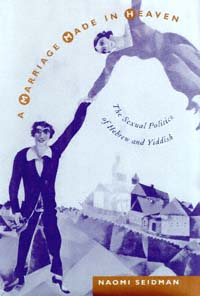 | Title: A marriage made in heaven: the sexual politics of Hebrew and Yiddish Author: Seidman, Naomi Published: University of California Press, 1997 Subjects: Jewish Studies | Gender Studies | Religion | Language and Linguistics Publisher's Description: With remarkably original formulations, Naomi Seidman examines the ways that Hebrew, the Holy Tongue, and Yiddish, the vernacular language of Ashkenazic Jews, came to represent the masculine and feminine faces, respectively, of Ashkenazic Jewish culture. Her sophisticated history is the first book-length exploration of the sexual politics underlying the "marriage" of Hebrew and Yiddish, and it has profound implications for understanding the centrality of language choices and ideologies in the construction of modern Jewish identity.Seidman particularly examines this sexual-linguistic system as it shaped the work of two bilingual authors, S.Y. Abramovitsh, the "grand-father" of modern Hebrew and Yiddish literature; and Dvora Baron, the first modern woman writer in Hebrew (and a writer in Yiddish as well). She also provides an analysis of the roles that Hebrew "masculinity" and Yiddish "femininity" played in the Hebrew-Yiddish language wars, the divorce that ultimately ended the marriage between the languages.Theorists have long debated the role of mother and father in the child's relationship to language. Seidman presents the Ashkenazic case as an illuminating example of a society in which "mother tongue" and "father tongue" are clearly differentiated. Her work speaks to important issues in contemporary scholarship, including the psychoanalysis of language acquisition, the feminist critique of Zionism, and the nexus of women's studies and Yiddish literary history. [brief] Similar Items |
| 44. | 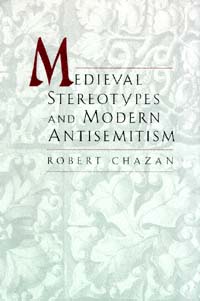 | Title: Medieval stereotypes and modern antisemitism Author: Chazan, Robert Published: University of California Press, 1997 Subjects: Medieval Studies | Jewish Studies | Medieval History | European History | European Studies Publisher's Description: The twelfth century in Europe, hailed by historians as a time of intellectual and spiritual vitality, had a dark side. As Robert Chazan points out, the marginalization of minorities emerged during the "twelfth-century renaissance" as part of a growing pattern of persecution, and among those stigmatized the Jews figured prominently.The migration of Jews to northern Europe in the late tenth century led to the development of a new set of Jewish communities. This northern Jewry prospered, only to decline sharply two centuries later. Chazan locates the cause of the decline primarily in the creation of new, negative images of Jews. He shows how these damaging twelfth-century stereotypes developed and goes on to chart the powerful, lasting role of the new anti-Jewish imagery in the historical development of antisemitism.This coupling of the twelfth century's notable intellectual bequests to the growth of Western civilization with its legacy of virulent anti-Jewish motifs offers an important new key to understanding modern antisemitism. [brief] Similar Items |
| 45. | 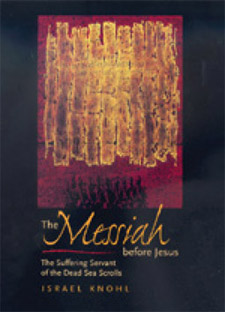 | Title: The messiah before Jesus: the suffering servant of the Dead Sea scrolls Author: Knohl, Israel Published: University of California Press, 2000 Subjects: Religion | Jewish Studies | Christianity Publisher's Description: In a work that challenges notions that have dominated New Testament scholarship for more than a hundred years, Israel Knohl gives startling evidence for a messianic precursor to Jesus who is described as the "Suffering Servant" in recently published fragments of the Dead Sea Scrolls. The Messiah before Jesus clarifies many formerly incomprehensible aspects of Jesus' life and confirms the story in the New Testament about his messianic awareness. The book shows that, around the time of Jesus' birth, there came into being a conception of "catastrophic" messianism in which the suffering, humiliation, and death of the messiah were regarded as an integral part of the redemptive process. Scholars have long argued that Jesus could not have foreseen his suffering, death, and resurrection because the concept of a slain savior who rises from the dead was alien to the Judaism of his time. But, on the basis of hymns found at Qumran among the Dead Sea Scrolls, Knohl argues that, one generation before Jesus, a messianic leader arose in the Qumran sect who was regarded by his followers as ushering in an era of redemption and forgiveness. This messianic leader was killed by Roman soldiers in the course of a revolt that broke out in Jerusalem in 4 B.C.E. The Romans forbade his body to be buried and after the third day his disciples believed that he was resurrected and rose to heaven. This formed the basis for Jesus' messianic consciousness, Knohl argues; it was because of this model that Jesus anticipated he would suffer, die, and be resurrected after three days. Knohl takes his fascinating inquiry one step further by suggesting that this messiah was a figure known to us from historical sources of the period. This identification may shed new light on the mystery of the "Paraclete" in the Gospel of John. A pathbreaking study, The Messiah before Jesus will reshape our understanding of Christianity and its relationship to Judaism. [brief] Similar Items |
| 46. | 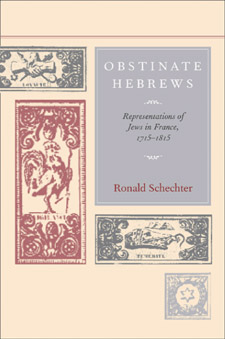 | Title: Obstinate Hebrews: representations of Jews in France, 1715-1815 Author: Schechter, Ronald Published: University of California Press, 2003 Subjects: History | European History | Jewish Studies | Intellectual History | French Studies Publisher's Description: Enlightenment writers, revolutionaries, and even Napoleon discussed and wrote about France's tiny Jewish population at great length. Why was there so much thinking about Jews when they were a minority of less than one percent and had little economic and virtually no political power? In this unusually wide-ranging study of representations of Jews in eighteenth-century France - both by Gentiles and Jews themselves - Ronald Schechteroffers fresh perspectives on the Enlightenment and French Revolution, on Jewish history, and on the nature of racism and intolerance. Informed by the latest historical scholarship and by the insights of cultural theory, Obstinate Hebrews is a fascinating tale of cultural appropriation cast in the light of modern society's preoccupation with the "other." Schechter argues that the French paid attention to the Jews because thinking about the Jews helped them reflect on general issues of the day. These included the role of tradition in religion, the perfectibility of human nature, national identity, and the nature of citizenship. In a conclusion comparing and contrasting the "Jewish question" in France with discourses about women, blacks, and Native Americans, Schechter provocatively widens his inquiry, calling for a more historically precise approach to these important questions of difference. [brief] Similar Items |
| 47. | 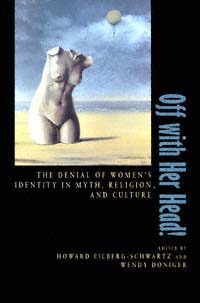 | Title: Off with her head!: the denial of women's identity in myth, religion, and culture Author: Eilberg-Schwartz, Howard 1956- Published: University of California Press, 1995 Subjects: Religion | Women's Studies | Cultural Anthropology | Classical Religions | Jewish Studies Publisher's Description: Whereas many books look at how women's bodies are represented in different religions and cultures around the world, this work explores the site of a woman's voice and identity, her head . The female head threatens to disrupt the classic gender distinctions that link men to speech, identity, and mind while relegating women to silence, anonymity, and flesh. The contributors to this collection argue that the objectification of women as sexual and reproductive bodies results in their symbolic beheading. Decapitation occurs symbolically in myths as well as in actual practices such as veiling, head covering, and cosmetic highlighting, which by sexualizing a woman's face turns it into an extension of her body.The essays explore how similar treatments of the female head find their unique articulation in diverse religious traditions and cultures: in Hindu myths of beheading, in Buddhist and Tantric practices and poetry about the hair of female nuns, in the resistance to veiling by early Christian women at Corinth, in contemporary veiling practices in a Turkish village, in the eroticization of the female mouth in ancient Judaism, and in Greek and Roman cosmetic practices.Together these essays show how the depiction of the female head is critical for an understanding of gender and its influence on other fundamental religious and cultural issues. [brief] Similar Items |
| 48. | 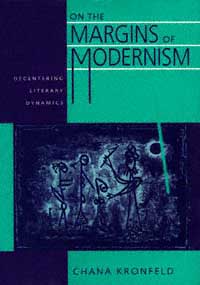 | Title: On the margins of modernism: decentering literary dynamics Author: Kronfeld, Chana Published: University of California Press, 1996 Subjects: Literature | Comparative Literature | Language and Linguistics | Literary Theory and Criticism | Jewish Studies Publisher's Description: Modernism valorizes the marginal, the exile, the "other" - yet we tend to use writing from the most commonly read European languages (English, French, German) as examples of this marginality. Chana Kronfeld counters these dominant models of marginality by looking instead at modernist poetry written in two decentered languages, Hebrew and Yiddish. What results is a bold new model of literary dynamics, one less tied to canonical norms, less limited geographically, and less in danger of universalizing the experience of minority writers.Kronfeld examines the interpenetrations of modernist groupings through examples of Hebrew and Yiddish poetry in Europe, the U.S., and Israel. Her discussions of Amichai, Fogel, Raab, Halpern, Markish, Hofshteyn, and Sutskever will be welcomed by students of modernism in general and Hebrew and Yiddish literatures in particular. [brief] Similar Items |
| 49. | 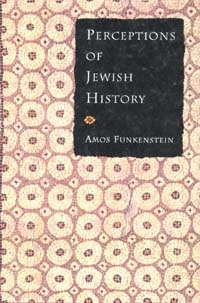 | Title: Perceptions of Jewish history Author: Funkenstein, Amos Published: University of California Press, 1993 Subjects: Jewish Studies | European History Similar Items |
| 50. | 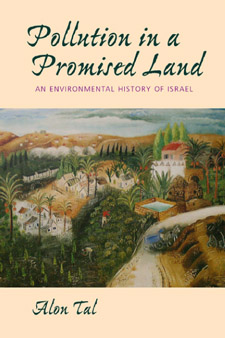 | Title: Pollution in a promised land: an environmental history of Israel Author: Tal, Alon 1960- Published: University of California Press, 2002 Subjects: EcologyEvolutionEnvironment | Jewish Studies | Ecology | Geography | Conservation Publisher's Description: Virtually undeveloped one hundred years ago, Israel, the promised "land of milk and honey," is in ecological disarray. In this gripping book, Alon Tal provides--for the first time ever--a history of environmentalism in Israel, interviewing hundreds of experts and activists who have made it their mission to keep the country's remarkable development sustainable amid a century of political and cultural turmoil. The modern Zionist vision began as a quest to redeem a land that bore the cumulative effects of two thousand years of foreign domination and neglect. Since then, Israel has suffered from its success. A tenfold increase in population and standard of living has polluted the air. The deserts have bloomed but groundwater has become contaminated. Urban sprawl threatens to pave over much of the country's breathtaking landscape. Yet there is hope. Tal's account considers the ecological and tactical lessons that emerge from dozens of cases of environmental mishaps, from habitat loss to river reclamation. Pollution in a Promised Land argues that the priorities and strategies of Israeli environmental advocates must address issues beyond traditional green agendas. [brief] Similar Items |
| 51. | 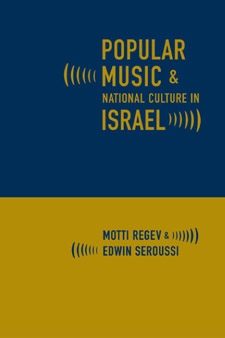 | Title: Popular music and national culture in Israel Author: Regev, Motti Published: University of California Press, 2004 Subjects: Music | Ethnomusicology | Middle Eastern Studies | Popular Culture | Jewish Studies Publisher's Description: A unique Israeli national culture - indeed, the very nature of "Israeliness" - remains a matter of debate, a struggle to blend vying memories and backgrounds, ideologies and wills. Identifying popular music as an important site in this wider cultural endeavor, this book focuses on the three major popular music cultures that are proving instrumental in attempts to invent Israeliness: the invented folk song repertoire known as Shirei Eretz Israel; the contemporary, global-cosmopolitan Israeli rock; and the ethnic-oriental musica mizrahit. The result is the first ever comprehensive study of popular music in Israel. Motti Regev, a sociologist, and Edwin Seroussi, an ethnomusicologist, approach their subject from alternative perspectives, producing a truly interdisciplinary, sociocultural account of music as a feature and a force in the shaping of Israeliness. A major ethnographic undertaking, describing and analyzing the particular history, characteristics, and practices of each music culture, Popular Music and National Culture in Israel maps not only the complex field of Israeli popular music but also Israeli culture in general. [brief] Similar Items |
| 52. | 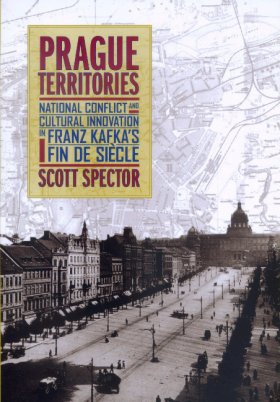 | Title: Prague territories: national conflict and cultural innovation in Franz Kafka's fin de siècle Author: Spector, Scott 1959- Published: University of California Press, 2002 Subjects: History of Food | European History | Jewish Studies | European Studies Publisher's Description: Scott Spector's adventurous cultural history maps for the first time the "territories" carved out by German-Jewish intellectuals living in Prague at the dawn of the twentieth century. Spector explores the social, cultural, and ideological contexts in which Franz Kafka and his contemporaries flourished, revealing previously unseen relationships between politics and culture. His incisive readings of a broad array of German writers feature the work of Kafka and the so-called "Prague circle" and encompass journalism, political theory, Zionism, and translation as well as literary program and practice. With the collapse of German-liberal cultural and political power in the late-nineteenth-century Habsburg Empire, Prague's bourgeois Jews found themselves squeezed between a growing Czech national movement on the one hand and a racial rather than cultural conception of Germanness on the other. Displaced from the central social and cultural position they had come to occupy, the members of the "postliberal" Kafka generation were dazzlingly productive and original, far out of proportion to their numbers. Seeking a relationship between ideological crisis and cultural innovation, Spector observes the emergence of new forms of territoriality. He identifies three fundamental areas of cultural inventiveness related to this Prague circle's political and cultural dilemma. One was Expressionism, a revolt against all limits and boundaries, the second was a spiritual form of Zionism incorporating a novel approach to Jewish identity that seems to have been at odds with the pragmatic establishment of a Jewish state, and the third was a sort of cultural no-man's-land in which translation and mediation took the place of "territory." Spector's investigation of these areas shows that the intensely particular, idiosyncratic experience of German-speaking Jews in Prague allows access to much broader and more general conditions of modernity. Combining theoretical sophistication with a refreshingly original and readable style, Prague Territories illuminates some early signs of a contemporary crisis from which we have not yet emerged. [brief] Similar Items |
| 53. | 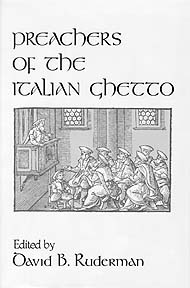 | Title: Preachers of the Italian ghetto Author: Ruderman, David B Published: University of California Press, 1992 Subjects: Jewish Studies | Medieval History | European History | History Publisher's Description: By the mid-sixteenth century, Jews in the cities of Italy were being crowded into compulsory ghettos as a result of the oppressive policies of Pope Paul IV and his successors.The sermons of Jewish preachers during this period provide a remarkable vantage point from which to view the early modern Jewish social and cultural landscape.In this eloquent collection, six leading scholars of Italian Jewish history reveal the important role of these preachers: men who served as a bridge between the ghetto and the Christian world outside, between old and new conventions, and between elite and popular modes of thought. The story of how they reflected and shaped the culture of their listeners, who felt the pressure of cramped urban life as well as of political, economic, and religious persecution, is finally beginning to be told. Through the words of the Italian ghetto preachers, we discover a richly textured panorama of Jewish life more than 400 years ago. [brief] Similar Items |
| 54. | 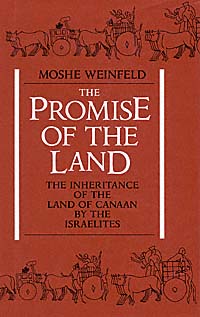 | Title: The promise of the land: the inheritance of the land of Canaan by the Israelites Author: Weinfeld, Moshe Published: University of California Press, 1993 Subjects: Jewish Studies | Middle Eastern Studies Publisher's Description: The settlement of the Land of Canaan by the Israelite tribes is a central theme in the Bible which is immensely relevant to the Middle East today.Moshe Weinfeld synthesizes the biblical material on this theme, approaching his subject from three viewpoints: historical, using the Bible as a source; literary-comparatist, comparing Patriarchal stories of settlement with Greek and Roman foundation myths; exegetical, explaining that in Judaism land is a gift from God. He emphasizes the ethical weight of God's Promise of the Land, how failure to achieve it was seen as a reflection of sin and lack of faith, thus illustrating the importance of biblical tradition to one of the most troubled issues of modern history. [brief] Similar Items |
| 55. | 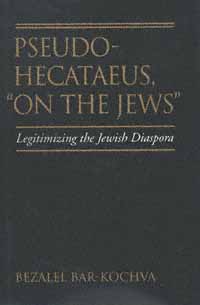 | Title: Pseudo-Hecataeus, On the Jews: legitimizing the Jewish diaspora Author: Bar-Kochva, Bezalel Published: University of California Press, 1997 Subjects: Jewish Studies | History | Ancient History | Jewish Studies Publisher's Description: Debate over the authenticity of "On the Jews" has persisted for nearly 1,900 years. Bezalel Bar-Kochva attempts to overcome this stalemate in his finely detailed and convincingly argued study that proves the forgery of the book and suggests not only a source for the text, but also a social, political, and cultural setting that explains its conception.Bar-Kochva argues that the author of this treatise belonged to the moderate conservative Jews of Alexandria, whose practices were contrary to the contemporary trends of Hellenistic Judaism. They rejected the application of Greek philosophy and allegorical interpretations of the Holy scriptures and advocated the use of Pentateuch Hebrew as the language for educating and for religious services. They showed a keen interest in Judea and identified themselves with the Jews of the Holy Land. "On the Jews," then, was the manifesto of this group and was written at the peak period of the Hasmonean kingdom. Its main purpose was to legitimize Jewish residence in Egypt, despite being explicitly prohibited in the Pentateuch, and to justify the continued residence of Jews there in a time of prosperity and expansion of the Jewish independent state. [brief] Similar Items |
| 56. | 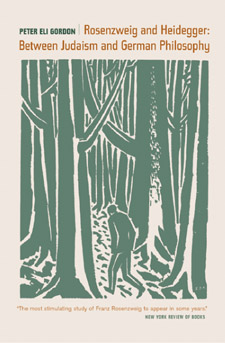 | Title: Rosenzweig and Heidegger: between Judaism and German philosophy Author: Gordon, Peter Eli Published: University of California Press, 2003 Subjects: History | German Studies | Religion | Judaism | European History | Intellectual History | Jewish Studies | Social and Political Thought Publisher's Description: Franz Rosenzweig (1886-1929) is widely regarded today as one of the most original and intellectually challenging figures within the so-called renaissance of German-Jewish thought in the Weimar period. The architect of a unique kind of existential theology, and an important influence upon such philosophers as Walter Benjamin, Martin Buber, Leo Strauss, and Emmanuel Levinas, Rosenzweig is remembered chiefly as a "Jewish thinker," often to the neglect of his broader philosophical concerns. Cutting across the artificial divide that the traumatic memory of National Socialism has drawn between German and Jewish philosophy, this book seeks to restore Rosenzweig's thought to the German philosophical horizon in which it first took shape. It is the first English-language study to explore Rosenzweig's enduring debt to Hegel's political theory, neo-Kantianism, and life-philosophy; the book also provides a new, systematic reading of Rosenzweig's major work, The Star of Redemption. Most of all, the book sets out to explore a surprising but deep affinity between Rosenzweig's thought and that of his contemporary, the German philosopher Martin Heidegger. Resisting both apologetics and condemnation, Gordon suggests that Heidegger's engagement with Nazism should not obscure the profound and intellectually compelling bond in the once-shared tradition of modern German and Jewish thought. A remarkably lucid discussion of two notably difficult thinkers, this book represents an eloquent attempt to bridge the forced distinction between modern Jewish thought and the history of modern German philosophy - and to show that such a distinction cannot be sustained without doing violence to both. [brief] Similar Items |
| 57. | 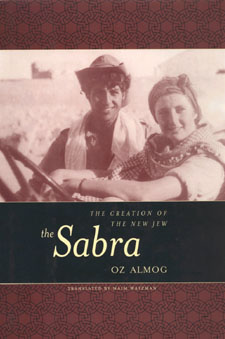 | Title: The Sabra: the creation of the new Jew Author: Almog, Oz Published: University of California Press, 2000 Subjects: Jewish Studies | Middle Eastern Studies | Sociology Publisher's Description: The Sabras were the first Israelis - the first generation, born in the 1930s and 1940s, to grow up in the Zionist settlement in Palestine. Socialized and educated in the ethos of the Zionist labor movement and the communal ideals of the kibbutz and moshav, they turned the dream of their pioneer forebears into the reality of the new State of Israel. While the Sabras made up a small minority of the new society's population, their cultural influence was enormous. Their ideals, their love of the land, their recreational culture of bonfires and singalongs, their adoption of Arab accessories, their slang and gruff, straightforward manner, together with a reserved, almost puritanical attitude toward individual relationships, came to signify the cultural fulfillment of the utopian ideal of a new Jew. Oz Almog's lively, methodical, and convincing portrayal of the Sabras addresses their lives, thought, and role in Jewish history. The most comprehensive study of this exceptional generation to date, The Sabra provides a complex and unflinching analysis of accepted norms and an impressive appraisal of the Sabra, one that any examination of new Israeli reality must take into consideration. The Sabras became Palmach commanders, soldiers in the British Brigade, and, later, officers in the Israel Defense Forces. They served as a source of inspiration and an object of emulation for an entire society. Almog's source material is rich and varied: he uses poems, letters, youth movement and army newsletters, and much more to portray the Sabras' attitudes toward the Arabs, war, nature, work, agriculture, cooperation, and education. In any event, the Sabra remained central to the founding myth of the nation, the real Israeli, against whom later generations will be judged. Almog's pioneering book juxtaposes the myths against the realities and, in the process, limns a collective profile that brilliantly encompasses the complex forces that shaped this remarkable generation. [brief] Similar Items |
| 58. | 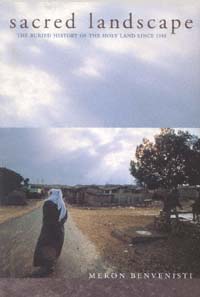 | Title: Sacred landscape: the buried history of the Holy Land since 1948 Author: Benvenisti, Meron 1934- Published: University of California Press, 2000 Subjects: Jewish Studies | Religion | Middle Eastern Studies | Politics Publisher's Description: As a young man Meron Benvenisti often accompanied his father, a distinguished geographer, when the elder Benvenisti traveled through the Holy Land charting a Hebrew map that would rename Palestinian sites and villages with names linked to Israel's ancestral homeland. These experiences in Benvenisti's youth are central to this book, and the story that he tells helps explain how during this century an Arab landscape, physical and human, was transformed into an Israeli, Jewish state.Benvenisti first discusses the process by which new Hebrew nomenclature replaced the Arabic names of more than 9,000 natural features, villages, and ruins in Eretz Israel/Palestine (his name for the Holy Land, thereby defining it as a land of Jews and Arabs). He then explains how the Arab landscape has been transformed through war, destruction, and expulsion into a flourishing Jewish homeland accommodating millions of immigrants. The resulting encounters between two peoples who claim the same land have raised great moral and political dilemmas, which Benvenisti presents with candor and impartiality.Benvenisti points out that five hundred years after the Moors left Spain there are sufficient landmarks remaining to preserve the outlines of Muslim Spain. Even with sustained modern development, the ancient scale is still visible. Yet a Palestinian returning to his ancestral landscape after only fifty years would have difficulty identifying his home. Furthermore, Benvenisti says, the transformation of Arab cultural assets into Jewish holy sites has engendered a struggle over the "signposts of memory" essential to both peoples. Sacred Landscape raises troublesome questions that most writers on the Middle East avoid. The now-buried Palestinian landscape remains a symbol and a battle standard for Palestinians and Israelis. But it is Benvenisti's continuing belief that Eretz Israel/Palestine has enough historical and physical space for the people of both nations and that it can one day be a shared homeland. [brief] Similar Items |
| 59. | 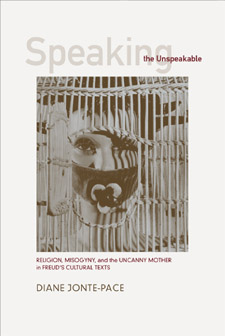 | Title: Speaking the unspeakable: religion, misogyny, and the uncanny mother in Freud's cultural texts Author: Jonte-Pace, Diane E. (Diane Elizabeth) 1951- Published: University of California Press, 2001 Subjects: Religion | Literature | Gender Studies | Jewish Studies | Psychology Publisher's Description: In this bold rereading of Freud's cultural texts, Diane Jonte-Pace uncovers an undeveloped "counterthesis," one that repeatedly interrupts or subverts his well-known Oedipal masterplot. The counterthesis is evident in three clusters of themes within Freud's work: maternity, mortality, and immortality; Judaism and anti-Semitism; and mourning and melancholia. Each of these clusters is associated with "the uncanny" and with death and loss. Appearing most frequently in Freud's images, metaphors, and illustrations, the counterthesis is no less present for being unspoken--it is, indeed, "unspeakable." The "uncanny mother" is a primary theme found in Freud's texts involving fantasies of immortality and mothers as instructors in death. In other texts, Jonte-Pace finds a story of Jews for whom the dangers of assimilation to a dominant Gentile culture are associated unconsciously with death and the uncanny mother. The counterthesis appears in the story of anti-Semites for whom the "uncanny impression of circumcision" gives rise not only to castration anxiety but also to matriphobia. It also surfaces in Freud's ability to mourn the social and religious losses accompanying modernity, and his inability to mourn the loss of his own mother. The unfolding of Freud's counterthesis points toward a theory of the cultural and unconscious sources of misogyny and anti-Semitism in "the unspeakable." Jonte-Pace's work opens exciting new vistas for the feminist analysis of Freud's intellectual legacy. [brief] Similar Items |
| 60. | 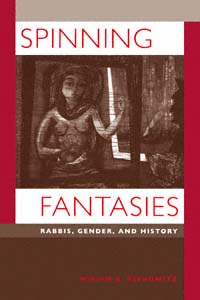 | Title: Spinning fantasies: rabbis, gender, and history Author: Peskowitz, Miriam 1964- Published: University of California Press, 1997 Subjects: Jewish Studies | Gender Studies | Ancient History Publisher's Description: Miriam Peskowitz offers a dramatic revision to our understanding of early rabbinic Judaism. Using a wide range of sources - archaeology, legal texts, grave goods, technology, art, and writings in Hebrew, Aramaic, Greek, and Latin - she challenges traditional assumptions regarding Judaism's historical development.Following the destruction of the Jerusalem Temple by Roman armies in 70 C.E., new incarnations of Judaism emerged. Of these, rabbinic Judaism was the most successful, becoming the classical form of the religion. Through ancient stories involving Jewish spinners and weavers, Peskowitz re-examines this critical moment in Jewish history and presents a feminist interpretation in which gender takes center stage. She shows how notions of female and male were developed by the rabbis of Roman Palestine and why the distinctions were so important in the formation of their religious and legal tradition.Rabbinic attention to women, men, sexuality, and gender took place within the "ordinary tedium of everyday life, in acts that were both familiar and mundane." While spinners and weavers performed what seemed like ordinary tasks, their craft was in fact symbolic of larger gender and sexual issues, which Peskowitz deftly explicates. Her study of ancient spinning and her abundant source material will set new standards in the fields of gender studies, Jewish studies, and cultural studies. [brief] Similar Items |